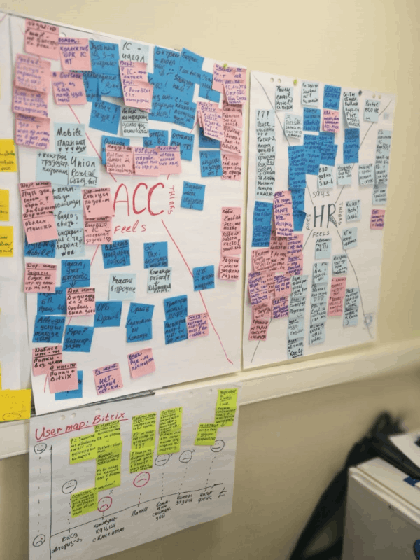BDO Unicon Outsourcing has launched MyBPO portal for employees and clients combining the features of a task manager, chats, file repositories, knowledge libraries, and Intranet providing access to the necessary information from anywhere in the world and yet compliant with all information security requirements. A few words about the project from Lyudmila Shusterova, Director for Strategic Development at BDO Unicon Outsourcing, and Nadezhda Massel, Head of Project Office at BDO Unicon Outsourcing.
ABOUT THE PORTAL

MyBPO has been nominated for award in the Digital Solutions category.
MyBPO is a unified solution for our employees and clients’ joint activities. This tool makes it possible for our colleagues and customers to:
-
Store and exchange documents via differentiated-access structured folders (e.g., an HR specialist can access HR and payroll records, but is unable to see financial statements);
-
Set tasks and monitor progress;
-
Communicate with the service team: ask questions about the files and obtain advice, monitor the processes under the teams’ liaison protocols with a clearly defined sequence, timeline, and employees in charge of these processes.
We are able to customize the portal for each individual client by posting a logo, and the clients themselves are now able to adjust personal views and notifications by events. If clients have any questions concerning the specialists’ performance quality, services, timeline, or any other matters during the provision of services, they no longer have to call or send complaints to BDO Unicon Outsourcing employees. Clients can now file a request on the portal, and their request will immediately be delivered to the employees in charge of the service quality.
The role and access rights differentiation system is the key feature of the solution. Employees’ roles and rights are agreed upon with the client, which makes it possible to protect data against unauthorized access. Employees’ access is limited to the tasks and documents falling within the scope of their relevant official duties.
BDO Unicon Outsourcing employees have acquired both a tool for convenient client communication and an Intranet with social media features where they can get prompt access to the information on developments in the company. Every user can like any publications and leave comments.

Thus, the portal has enabled us to integrate at least five diverse tools and stay compliant with the security requirements at the same time.
PROJECT BACKGROUND
The first time we thought about developing the portal was back in July 2016 when we saw demand on the part of both our clients and employees. Our colleagues used to exchange documents with customers via file sharing services, SFTP channels, our headquarters’ portal, etc. MS Outlook was used as the primary channel of related correspondence. Some clients requested additional correspondence in messengers. We used third-party apps for briefings and we had to pay the relevant subscription fees. As a result, we used to spend excessive resources on file search and correspondence history, which was a major handicap to communication.
Besides, we had no Intranet — we used to communicate with our employees by means of newsletters. The corporate newsletter prepared by the marketing office on a monthly basis was the only source of information on developments in the company for our employees.
SELECTING THE PLATFORM AND PROVIDER
We wanted to integrate file sharing and all types of communications in a one-stop solution. To that end, we started examining the technical implementation options, our peculiarities, including user experience, B2B context, our protocols, front-end requirements, and security requirements.
When selecting the platform for our portal, we had to consider multiple factors at once: we were supposed to create a solution both for internal and external users who already had diverse corporate tools, and every client had its own quality and security certificates. Furthermore, we had to abide by Federal Law No. 152-FZ on personal data protection — our company is a registered personal data processing operator. This is why the selection of the engineering solution required a comprehensive study of the market and products that covered 3 dimensions:
-
Platform: we considered three contemporary platforms (including two international and one local platform) and the possibility of developing our own platform from scratch, as multi-level access rights might prove incompatible with the existing solutions;
-
Solution: cloud and server apps offered on the platforms mentioned above;
-
Providers: potential and experience in implementing similar solutions.
In the end, we opted for SharePoint Online — a cloud product in Microsoft Office 365 package, since a cloud solution is the only solution ensuring ongoing product updating and development. Our users’ professional activities are developing and evolving every day, and they expect the same from related tools.

Economic benefit served as another decisive factor. We would not have to look for internal resources to maintain the portal and substitutes for the duration of a vacation or sick leave. In addition, product rental is much less expensive than the purchase of a solution with the need to renew the license package later on.
PROJECT TEAM
This project was initiated by the company management. It was implemented by the design office starting from selecting the solution up to launching the portal into commercial operation. Out of all business units, the accounting department was most heavily involved. The department director ensured prompt collection of users’ requirements, took energetic effort to engage the department employees, and promoted the portal with would-be users.
Besides, representatives of HR department and marketing office took part in the focus groups — this was the team that discussed and tested the publication of information for our employees.
PROJECT PHASES
In December 2016, the project team started collecting the company managers’ and directors’ requirements to build the concept of the product to be developed and select the engineering solution.
In July 2017, we collected the preferences of the portal immediate users: BDO Unicon Outsourcing clients and employees. Despite the fact the portal was initially conceived as a B2B product, we were well aware of the diverse user experience of the people behind the business. For instance, in case of clients, the portal may be used by an office manager or general director of a Russian or international company with contacts in the headquarters located abroad. In addition, all users have a vast experience of dealing with diverse state-of-the-art platforms with a similar set of features. Thus, we had no margin for error and we were aware of the fact that the portal would be compared to the customary tools familiar to our users on both sides.
We were concerned about potential opposition on the part of our employees, in particular, on the part of conservative accountants who were used to working in a single program and unwilling to use any upgraded tools. This was the reason why the second requirement collection phase focused on the user involving Design Thinking — a user-oriented method to create products and services. This process involved 40 persons: our employees, clients, and partners. We took in-depth interviews, made user maps, conducted Trend mapping, generated ideas, prototyped the product interface subject to our users’ top-priority requirements and user experience.

In December 2017, our provider launched the development of the product primary lead. The adjustment and finalization phase was completed in April 2019. This was followed by the testing of the portal involving over 20 employees from diverse units. Every employee was responsible for various roles with different access rights: client, manager, employee of a business unit, etc. This phase was completed in July 2019.
Thereafter, we opened access to the portal Intranet to our colleagues. They acquired an opportunity to find the necessary documents and files quickly and receive prompt updates about developments in the company.
In addition, our colleagues acquired access to the Knowledge Base where they can find the materials prepared by our methodology experts. If any information becomes outdated, employees can request updates. For instance, they enjoy access to the up-to-date official letters of the Ministry of Finance, digests on legislative changes by BDO experts, etc.
In late 2019, we transferred our first active client to the portal. According to this client, the portal has made work easier, as documents are now stored in a well-organized manner and in a single place and it is easy to find and review them.
DEALING WITH COMPLEXITY
MyBPO is based on a cloud solution. This arrangement is characterized by both benefits and constraints: we are continuously acquiring new features and updates online, but are unable to customize the portal subject to all of our preferences.
Access rights tied to the client website folder structure constituted the most challenging module in terms of implementation. On the one hand, we were not in the position to modify or lower the requirements to the allocation of access rights in any way, and on the other, the cloud solution would not allow for the implementation of a complex and excessively detailed structure. We found the solution by striking a balance between the structure we optimized and rights customization effected by the provider. We found a satisfactory option by iterating the setting several times and testing the module.
FEEDBACK FROM EMPLOYEES AND PARTNERS
Despite our concerns, employees embarked upon the testing of the portal with enthusiasm. They switched over to the portal quickly and started using its tools. For instance, the portal task manager became quite popular with our employees. This came as a surprise, as we were certain that the users would start mastering basic features in the new format before everything else.
As for the first external users, we were genuinely surprised by their interest in adding extra color solutions. We have not decided yet whether we want to comply with this request.
It is crucial to remember that the portal provides for major changes in our company employees’ operating procedures. This is the reason why we took so much effort to prepare for the launch and engage our colleagues in order to minimize internal opposition to the new tool. Judging by our team members’ feedback, we have accomplished our task. The only feedback we receive is positive, and employees review the newsfeed with enthusiasm and leave their comments. However, we do realize that the task of ensuring full adaptation and acceptance of this change requires ongoing monitoring and portal development subject to our users’ requirements.
IMPLEMENTATION RESULTS
The portal is currently used by 100% of our employees.
MyBPO helped us depart from any third-party apps and other resources, and therefore, reduce the time input in communication and in file and document search by 30%. Moreover, we are planning to improve these figures.

Our employees have acquired online access to information on developments in the company. In addition, the social media features make it possible to see our colleagues’ feedback to the newsfeed. Available viewing statistics enables the marketing office to track the most popular pieces of news and adjust content accordingly.
Six months after the launch of the portal, we conducted an employee engagement survey. The findings demonstrate that the number of employees obtaining sufficient information on developments in the company has risen by 18%.
Source:



